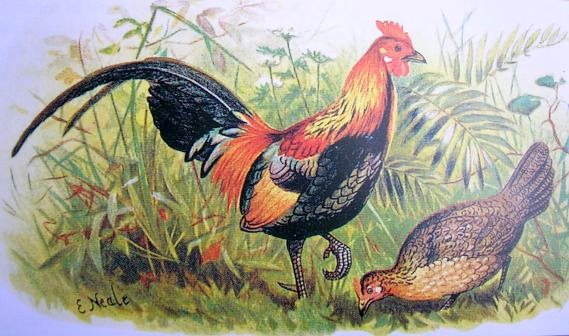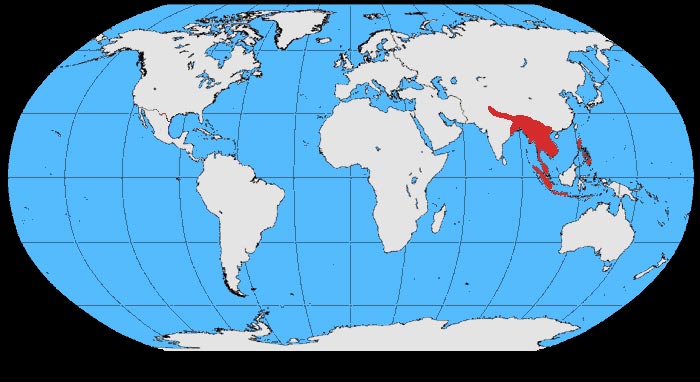- Red Junglefowl
Taxobox
name = Red Junglefowl
status = LC
status_system = iucn3.1

regnum =Animal ia
phylum = Chordata
classis = Aves
ordo =Galliformes
familia =Phasianidae
genus = "Gallus"
species = "G. gallus"
binomial = "Gallus gallus"
binomial_authority = (Linnaeus, 1758)
range_
range_map_width = 240px
range_map_caption = Red Junglefowl rangeThe Red Junglefowl, "Gallus gallus", is atropical member of thePheasant family, and is often believed to be the direct ancestor of the domesticchicken . While the domestic chicken has mostly derived from the Red Junglefowl, recent research done by Eriksson et al. suggests possible hybridisation with theGrey Junglefowl .Eriksson J, Larson G, Gunnarsson U, Bed'hom B, Tixier-Boichard M, et al. (2008) "Identification of the Yellow Skin Gene Reveals a Hybrid Origin of the Domestic Chicken." PLoS Genet January 23, 2008 [http://genetics.plosjournals.org/perlserv/?request=get-document&doi=10.1371%2Fjournal.pgen.1000010.eor&ct=1] .] It was first raised in captivity at least several thousand years ago in theIndian subcontinent , and thedomesticated form has been taken all around the world as a very productive food source for both meat and eggs, which some breeds have been specifically developed to produce.The range of the true species stretches from northeast India (where the pure species has almost certainly been diluted with back-crosses from domestic breeds) eastwards across southern
China and down intoMalaysia andIndonesia .The birds are also domesticated inKenya . They were probably introduced into the country by the influx ofIndia ns during the early 1900's, when they were brought into Kenya to build the railway.Each of these various regions had its own subspecies such as:
* "Gallus gallus gallus"Indochina
* "Gallus gallus bankiva" Java - Bankiva Fowl
* "Gallus gallus jabouillei"Vietnam
* "Gallus gallus murghi"India
* "Gallus gallus spadiceus"Burma (considered by some the true ancestor of the domestic bird)
* "Gallus gallus domesticus" (the domesticChicken )Male andfemale birds show very strongsexual dimorphism . Males are much larger; they have large red fleshy wattles on the head and long, bright gold and bronze feathers forming a "shawl" or "cape" over the back of the bird from the neck to the lower back. The tail is composed of long, arching feathers that initially look black but shimmer with blue, purple and green in good light. The female'splumage is typical of this family of birds in being cryptic and designed for camouflage as she alone looks after the eggs and chicks. She also has no fleshy wattles on the head.During the breeding season, the male birds announce their presence with the well known "cock-a-doodle-doo" call. This serves both to attract potential mates and to make other male birds in the area aware of the risk of fighting a breeding competitor. The lower leg just behind and above the foot has a long spur for just this purpose. Their call structure is complex and they have distinctive alarm calls for aerial and ground predators to which others react appropriately. [Collias, N. E. 1987. The vocal repertoire of the Red Junglefowl: A spectrographic classification and the code of communication. The Condor 89:510-524] [Evans, C. S., Macedonia, J. M., and Marler, P. (1993). Effects of apparent size and speed on the response of chickens, Gallus gallus, to computer-generated simulations of aerial predators. Animal Behaviour 46: 1-11.]
Flight in these birds is almost purely confined to reaching their roosting areas at sunset in trees or any other high and relatively safe places free from ground predators, and for escape from immediate danger through the day.
Current research testing the genetic integrity of this species across its natural range appears to prove that the pure form is quite rare and may even be extinct, only represented in the wild by birds with various degrees of back crossing with domestic selections (breeds) of the species.
The other three members of the genus —
Sri Lanka Junglefowl ("Gallus lafayetii"),Grey Junglefowl ("Gallus sonneratii"), and theGreen Junglefowl ("Gallus varius") — do not produce fertile hybrids with the Red Junglefowl, suggesting that it is the sole ancestor of the domestic chicken. However, recent research has revealed the absence of the yellow skin gene in the wild Red Junglefowl found in domestic birds, which suggests hybridisation with the Grey Junglefowl during the domestication of the species.Genetic pollution and threat of extinction
* Wild
Jungle fowl , specificallyRed Junglefowl in India and South Asia are presumed to be the ancestor of all poultry chickens. These are thought to be facing a serious threat ofextinction because ofgenetic pollution which is occurring at the edge of forests where domesticated free ranging chickens are commonly kept in bordering villages and towns [ [http://www.feathersite.com//Poultry/NDG/RJFbySPPA.html CONCERNS FOR THE GENETIC INTEGRITY AND CONSERVATION STATUS OF THE RED JUNGLEFOWL by I. Lehr Brisbin, Jr. Savannah River Ecology Laboratory, Drawer E, Aiken, SC 29802 (with permission from SPPA Bulletin, 1997, 2(3):1-2) FeatherSite. Retrieved on September 19, 2007] , [http://www.feathersite.com//Poultry/SPPA/SPPA.html Society for the Preservation of Poultry Antiquities] , [http://www.feathersite.com//Poultry/NDG/BRKRedJF.html Red Junglefowl (Gallus gallus) page & links] , [http://www.feathersite.com/ FeatherSite by Barry Koffler] ] [ [http://www.wildfowl.uconn.edu/43115306-6278-49db-b761-9f7700fe64f9-9.html Morphological and Behavioral Characteristics of Genetically Pure Indian Red Junglefowl, Gallus gallus murghi By Tomas P. Condon. Retrieved on September 19, 2007] , [http://www.wildfowl.uconn.edu/ THE JUNGLEFOWL PAGES: These pages were created to provide a reference guide to the four species of the genus Gallus, commonly known as junglefowl. It contains information and photographs of the each of the species. By Tomas P. Condon] ] [ [http://www.cvpws.com/junglefowl2.html Hawkins, W.P. (n.d.). Carolinas/Virginia Pheasant & Waterfowl Society. Red Junglefowl – Pure Strain. Retrieved on September 19, 2007] ] [ [http://animaldiversity.ummz.umich.edu/site/accounts/information/Gallus_gallus.html Gautier, Z. 2002. "Gallus gallus" (On-line), Animal Diversity Web. Accessed September 19, 2007] ] [ [http://www.wildlifetrustofindia.org/html/news/2006/060113_red_jungle_fowl.html Genetic invasion threatens red jungle fowl, Wildlife Trust of India, New Delhi, 9 January, 2006, Accessed September 19, 2007] , [http://southasia.oneworld.net/article/view/125725/1/8674] ] [ [http://www.birdlife.org/news/news/2000/06/9.html Red Junglefowl genetically swamped, 01-06-2000, According to some scientists, truly wild populations of the Red Junglefowl Gallus gallus are either extinct or in grave danger of extinction due to introgression of genes from domestic or feral chickens. Tragopan No. 12, p. 10, World Birdwatch 22 (2). Accessed September 19, 2007 from BirdLife International] , [http://www.birdlife.org/datazone/species/index.html?action=SpcHTMDetails.asp&sid=246&m=0 Red Junglefowl - BirdLife Species Factsheet, BirdLife International (2007) Species factsheet: Gallus gallus. Downloaded Accessed on 20/9/2007] ] [ [Peterson, A.T. and I.L. Brisbin, Jr.: 1999. Genetic endangerment of wild red junglefowl (Gallus gallus) ? Bird Conservation International (Vol. 9) pp. 387-394.] ] [ [Brisbin, I. L., Jr. (1969). Behavioral differentiation of wildness in two strains of Red Junglefowl (abstract). Amer. Zool. 9:1072.] ] .Cited references
Other references
* Database entry includes justification for why this species is of least concern
* [http://economictimes.indiatimes.com/Earth/Flora__Fauna/Ancestors_of_chickens_studied_for_conservation/articleshow/3336847.cms Ancestors of chickens studied for conservation; 7 Aug, 2008; The Economic Times, Times of India]External links
* ARKive - [http://www.arkive.org/species/GES/birds/Gallus_gallus/ images and movies of the Red Junglefowl "(Gallus gallus)"]
* [http://www.birdlife.org/datazone/species/index.html?action=SpcHTMDetails.asp&sid=246&m=0 BirdLife Species Factsheet]
* [http://www.redlist.org/search/details.php?species=47071 IUCN Red List]
* [http://feathersite.com/Poultry/NDG/BRKRedJF.html Many images at FeatherSite.com]
* [http://animalsinthecity2.webs.com/vietnamesejf.htm Images of the San Diego Zoo, Richardson (Laos), and Vietnamese Strain]
Wikimedia Foundation. 2010.
